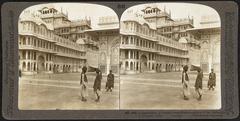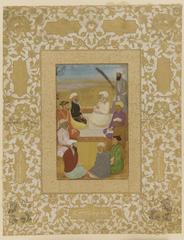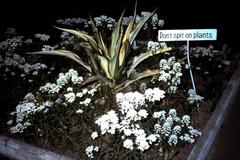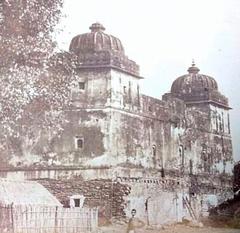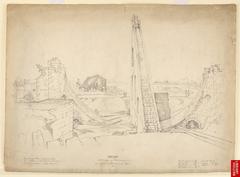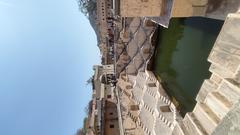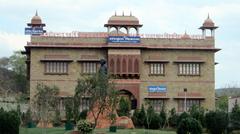Sisodiya Rani Bagh Visiting Hours, Tickets, and Historical Significance - Your Ultimate Guide
Date: 18/07/2024
Introduction
Sisodiya Rani Bagh, also known as Sisodia Rani Garden, is a historical garden located in Jaipur, Rajasthan. Constructed in 1728 by Maharaja Sawai Jai Singh II for his second queen, this garden serves as a testament to royal love and architectural grandeur (source). The garden is a harmonious blend of Mughal and Rajputana architectural styles, featuring multi-tiered layouts, cascading fountains, and intricately painted pavilions. Visitors are transported back to an era of opulence and artistic finesse as they explore the site’s lush landscapes and historical structures. With its rich history, cultural significance, and aesthetic beauty, Sisodiya Rani Bagh offers a unique and tranquil retreat for locals and tourists alike. This guide aims to provide comprehensive information on the garden’s history, architecture, visiting hours, ticket prices, and travel tips to ensure a memorable visit.
Table of Contents
- Introduction
- Mughal-Inspired Architecture with a Rajputana Touch
- The Multi-Tiered Garden Layout
- Water Features - The Lifeline of the Garden
- The Exquisitely Painted Pavilions and Galleries
- The Sisodia Rani Palace - A Royal Abode
- The Intricate Frescoes - Stories Etched in Time
- Exploring the Garden - Key Attractions and Tips
- Special Events and Guided Tours
- FAQ
- Conclusion
Mughal-Inspired Architecture with a Rajputana Touch
The architectural style of Sisodiya Rani Bagh showcases a fascinating fusion of Mughal aesthetics and Rajputana influences. While the garden’s overall design draws inspiration from the famed Mughal gardens of Kashmir, it incorporates distinct Rajput architectural elements, creating a unique and captivating blend.
The Multi-Tiered Garden Layout
The garden’s design unfolds across multiple tiers, each offering a unique perspective of the surrounding landscape. This terraced layout, reminiscent of Mughal gardens like Shalimar Bagh in Srinagar (source), creates a sense of depth and grandeur. Visitors can wander through these levels, discovering hidden fountains, secluded pavilions, and breathtaking views at every turn.
Water Features - The Lifeline of the Garden
Water plays a pivotal role in the garden’s design, not just as a visual element but also as a symbol of life and abundance. Cascading fountains, serene pools, and strategically placed water channels create a soothing and refreshing atmosphere. The sound of flowing water adds to the garden’s tranquility, offering respite from the often-chaotic world outside.
The Exquisitely Painted Pavilions and Galleries
Scattered throughout the garden are beautifully painted pavilions and galleries, each adorned with intricate frescoes depicting scenes from Hindu mythology, particularly the epic love story of Radha and Krishna. These paintings, a hallmark of Rajput artistry, add a vibrant splash of color to the garden’s verdant embrace. The pavilions, with their delicate arches and ornate pillars, provide shaded retreats for visitors to pause and soak in the surrounding beauty.
The Sisodia Rani Palace - A Royal Abode
At the heart of the garden lies the Sisodia Rani Palace, a two-storied structure that served as a summer retreat for the queen and her court. The palace’s architecture reflects the opulence and grandeur of the Rajput era, with its spacious chambers, airy balconies, and exquisite views of the garden. The palace’s interior, though now mostly bare, still hints at its former splendor, with remnants of intricate murals and delicate mirror work.
The Intricate Frescoes - Stories Etched in Time
The frescoes adorning the pavilions and galleries are a major highlight of Sisodia Rani Bagh. These murals, painted using natural pigments, depict scenes from the life of Lord Krishna, showcasing the playful deity’s romance with Radha and his divine exploits. The intricate details, vibrant colors, and expressive figures bring these stories to life, offering a glimpse into the rich tapestry of Hindu mythology.
The Garden’s Symbolism - A Testament to Love
Beyond its aesthetic appeal, Sisodia Rani Bagh holds deep symbolism, representing the love and devotion of Maharaja Sawai Jai Singh II for his beloved queen. The garden’s very existence, a verdant oasis amidst the arid landscape, speaks volumes about the lengths to which the king went to please his queen. The numerous depictions of Radha and Krishna further emphasize this theme of love and devotion, making the garden a testament to the enduring power of human connection.
Exploring the Garden - Key Attractions and Tips
- Take your time: Sisodia Rani Bagh is best enjoyed at a leisurely pace. Allow ample time to wander through the different levels, admire the intricate details of the architecture and frescoes, and simply soak in the tranquil atmosphere.
- Capture the beauty: The garden offers numerous picturesque spots perfect for photography. Don’t forget to bring your camera to capture the beauty of the cascading fountains, vibrant frescoes, and panoramic views.
- Plan your visit: The garden is open from sunrise to sunset. Visiting during the cooler hours of the day, especially during the summer months, is advisable. Check the official website for the latest Sisodia Rani Bagh visiting hours and any special events.
- Tickets and entry: Entry tickets can be purchased at the gate. For updated Sisodia Rani Bagh ticket prices, refer to the official website or local tourist information centers.
- Respect the heritage: Remember that Sisodia Rani Bagh is a historical site. Be mindful of the surroundings and refrain from touching or damaging the structures and artwork.
- Nearby attractions: While in Jaipur, consider visiting other historical sites such as the Amber Fort, City Palace, and Jantar Mantar to enrich your cultural experience.
Special Events and Guided Tours
Sisodia Rani Bagh occasionally hosts cultural events and festivals that provide an immersive experience of Rajasthani heritage. Guided tours are available, offering in-depth historical insights and fascinating anecdotes about the garden.
FAQ
Q: What are the Sisodia Rani Bagh visiting hours?
A: The garden is open from sunrise to sunset. Check the official website for any changes in timings.
Q: How much are the Sisodia Rani Bagh tickets?
A: Ticket prices vary for locals and tourists. Refer to the official website or local tourist centers for the latest prices.
Q: Are guided tours available?
A: Yes, guided tours can be arranged through local tour operators or the garden’s administration.
Q: Is Sisodia Rani Bagh accessible for people with disabilities?
A: While the garden has some accessibility features, the multi-tiered layout may pose challenges. It’s advisable to check with the administration for specific accessibility information.
Q: Can I take photos in the garden?
A: Yes, photography is allowed. The garden offers numerous picturesque spots perfect for capturing its beauty.
Conclusion
Sisodia Rani Bagh stands as a magnificent testament to the architectural brilliance and cultural richness of Jaipur. From its Mughal-inspired multi-tiered garden layout to the intricate frescoes depicting scenes from Hindu mythology, every aspect of this historical site offers a glimpse into the grandeur of the Rajputana era (source). The garden’s symbolism, reflecting the love and devotion of Maharaja Sawai Jai Singh II for his queen, adds an emotional depth to its aesthetic allure. Visitors can enjoy a serene escape amidst the cascading fountains and beautifully painted pavilions, making it a must-visit destination for anyone interested in history and culture. Whether you’re capturing picturesque views, exploring nearby attractions, or attending special events, Sisodia Rani Bagh promises an enriching and unforgettable experience. For more updates and travel tips, download the Audiala mobile app and follow us on social media.
References
- Visiting Sisodia Rani Bagh - History, Architectural Wonders, and Visitor Tips, 2024, Author https://www.kashmirtourism.in/shalimar-bagh.html
- Exploring Sisodiya Rani Bagh - A Cultural and Historical Gem in Jaipur, 2024, Author https://www.kashmirtourism.in/shalimar-bagh.html

